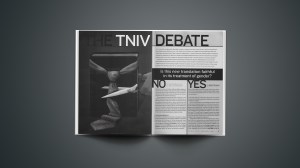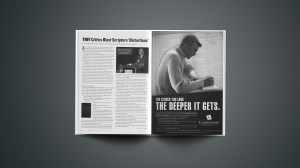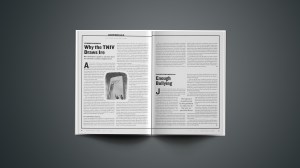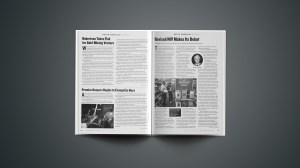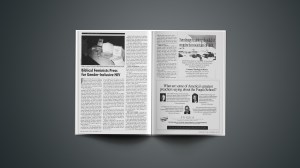In this series

At their annual summer convention, the Southern Baptists passed a resolution expressing "profound disappointment with Biblica and Zondervan Publishing House" for publishing the 2011 New International Version, concluding that "we cannot commend the 2011 NIV to Southern Baptists or the larger Christian community."
The resolution strikes us as divisive, shortsighted, and something that brings us, and no doubt the majority of the Christian community, profound disappointment.
To be fair, the resolution was not brought to the convention by the resolution committee, which wisely determined that the convention did not need to comment on the new translation. The resolution was the work of a single delegate, and only one other person spoke on its behalf. But no one on the convention floor spoke against it, and eyewitnesses say that up to 90 percent of the delegates raised their ballots to signal their approval.
The issue at stake is what the resolution called the NIV'S "gender-neutral methods of translation," saying the 2011 NIV has "gone beyond acceptable translation standards."
Whose translations standards are they talking about? The translation principle the resolution refers to is properly called "dynamic equivalence" or "functional equivalence." Such translations try to do something on the order of common sense: When arriving at a word or phrase that literally says one thing but functionally means another, they choose the functional meaning.
In biblical times, speakers would address a mixed group of believers with the greeting "brothers." Such was the practice even in English a generation ago. If a speaker were to do that today, many people in the room would assume the speaker was addressing his remarks only to the men present. If we translate the Greek word adelphoi as "brothers" in many biblical passages, it would lead the modern reader to the same conclusion. In short, it would mislead the reader. Hence, the need for functional translations.
No single translation method can possibly convey with complete accuracy the biblical text.
Functional equivalence is the principle used by the New Living Translation, published by Tyndale. And by the New Century Version, published by Thomas Nelson. We have no reason to believe that such publishing houses, or the reputable evangelical scholars who produced their versions, are driven by a secular feminist agenda.
Even so-called formal equivalence translations—which do their best to translate the original languages word for word and syntactical structure for syntactical structure—regularly resort to functional equivalence. The English Standard Version, for example, always uses the word man for the Greek anthropos when the context suggests a male human is in view. This is a literal and accurate translation in such cases. But when the context suggests that both men and women are in view, it uses people or others. This is a functional and accurate translation.
To be clear, no contemporary, evangelically based translation changes the gendered names used in God's self-revelation. The first person of the Trinity is still called "Father," and Jesus is his "Son."
One SBC concern is ideology, a commitment to complementarianism, the view that men and women have different, divinely appointed roles in church and home. We all should be concerned about any translation that lets an ideology shape its language. But we should not let ideology—egalitarianism or complementarianism—determine whether a translation is valuable or not. The only criterion for a good translation is this: Does it accurately convey what the authors said and what the original listeners heard?
No single translation method can possibly convey with complete accuracy the biblical text. An Italian proverb sums it up well: Traduttore traditore, "The translator is a traitor." There is, indeed, always something lost in translation. So we need both formal and functional equivalence biblical translations. Formal equivalence translations highlight what the text literally said. Functional equivalent translations highlight how that text was originally heard. Only when we employ these together can we begin to approximate Scripture's deepest and broadest meaning.
We are convinced that the Southern Baptists want to grasp the deepest and broadest meaning of Scripture. Thus, we strongly encourage them to rethink the resolution and make room for a variety of translations.
Apparently, variety has led to an increased investment in the Bible among Southern Baptists. LifeWay, the SBC's bookstore chain, recently reported that its Bible sales have doubled since 2005. The sales include tens of thousands of the NIV Study Bible, the Archaeological Study Bible, the Quest Study Bible, and a host of other devotional and reference Bibles—not to mention the New Living Bible, the New Century Bible, and their ancillary products. Such versions have helped Southern Baptists and others grow in their faith in Jesus Christ.
Our advice: Don't do as the Southern Baptists say at their conventions. Do as they do in their bookstores.
Copyright © 2011 Christianity Today. Click for reprint information.
Related Elsewhere:
For the Southern Baptist Convention's full resolution on the 2011 NIV, visit SBC.net.
Other Bible translation resources include:
The American Bible Society's website, featuring information about the Bible and Bible translation.
The Bible Gateway, an online interface that allows visitors to compare specific verses in various translations and languages.
Additional Christianity Today articles on Bible translation include:
Eugene Nida, Who Revolutionized Bible Translations, Dead at 96 | His "dynamic equivalence" approach is used by many modern versions. (August 26, 2011)
A World Without the King James Version | Where we would be without the most popular English Bible ever. (May 6, 2011)
We Really Do Need Another Bible Translation | As good as many modern versions are, they often do not allow us to hear what the Holy Spirit actually said. (October 22, 2001)
Old Wisdom for New Times | The International Bible Society is doing "spiritual archaeology" and retro-publishing to reach seekers. (April 23, 2001)
New Bible translations help to preserve world's disappearing languages | The total number of languages in which the Bible is available in part or in its entirety now stands at 2233. (February 28, 2000)
What Bible Version Did Jesus Read? | What does the knowledge that Jesus used different versions of Scripture mean for us today? (April 26, 1999)
Confessions of a Bible Translator | As a stylist on a new translation of the Bible, Daniel worries over the effectiveness of the language into which the text is translated. (October 27, 1997)
CT also has more editorials on our site.





